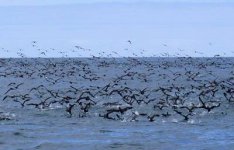The name Hutton has rarely been out of the UK press in recent weeks, due to a certain infamous inquiry. Yet conservationists in New Zealand have been aware of the name for years, due to a species of globally threatened seabird, the Hutton's Shearwater Puffinus huttoni.
Although Hutton's Shearwater was first described in 1912, the location of its nesting sites remained unknown until 1965 when shearwater burrows were reported by a local deerstalker high on the Seaward Kaikoura Range of New Zealand's South Island. Further investigation revealed that these burrows, located on steep tussock and scrub-covered slopes between 1,200 and 1,800 metres, belonged to Hutton's Shearwaters.
Subsequently it has emerged that the entire world population of the shearwater nests only in two localities in the Seaward Kaikoura Range, between 10–18 km inland. The species' population was previously estimated to be around 135,000 pairs, but more recent surveys have placed the number closer to 100,000 pairs.
With breeding confined to just two locations and several potential threats facing the species, Hutton's Shearwater has been classified as Endangered. The main threats are to the birds' nesting habitat, which is vulnerable to erosion, perhaps as a result of grazing by introduced mammals such as deer and chamois. Feral pigs and cats also pose a threat, but fortunately are normally absent from the colonies. The Department of Conservation intends to relocate birds to establish another breeding colony elsewhere in the Seaward Kaikoura Range, in order to spread the risk of these threats.
It was feared that predation by introduced stoats posed a serious threat to the shearwaters. However, a survey carried out between 1989–1999 suggests that although stoats were estimated to be killing 12% of chicks each season (and 0.25% of adults), overall this was not causing a population decline. Conservation efforts should focus first on the other issues affecting the species.
Given the appalling problems caused by stoats and other introduced mammals to New Zealand's native birdlife, this is a welcome piece of news.
Dave Gandy
A flock of Hutton's Shearwaters Puffinus huttoni off Kaikoura, on New Zealand's South Island
Although Hutton's Shearwater was first described in 1912, the location of its nesting sites remained unknown until 1965 when shearwater burrows were reported by a local deerstalker high on the Seaward Kaikoura Range of New Zealand's South Island. Further investigation revealed that these burrows, located on steep tussock and scrub-covered slopes between 1,200 and 1,800 metres, belonged to Hutton's Shearwaters.
Subsequently it has emerged that the entire world population of the shearwater nests only in two localities in the Seaward Kaikoura Range, between 10–18 km inland. The species' population was previously estimated to be around 135,000 pairs, but more recent surveys have placed the number closer to 100,000 pairs.
With breeding confined to just two locations and several potential threats facing the species, Hutton's Shearwater has been classified as Endangered. The main threats are to the birds' nesting habitat, which is vulnerable to erosion, perhaps as a result of grazing by introduced mammals such as deer and chamois. Feral pigs and cats also pose a threat, but fortunately are normally absent from the colonies. The Department of Conservation intends to relocate birds to establish another breeding colony elsewhere in the Seaward Kaikoura Range, in order to spread the risk of these threats.
It was feared that predation by introduced stoats posed a serious threat to the shearwaters. However, a survey carried out between 1989–1999 suggests that although stoats were estimated to be killing 12% of chicks each season (and 0.25% of adults), overall this was not causing a population decline. Conservation efforts should focus first on the other issues affecting the species.
Given the appalling problems caused by stoats and other introduced mammals to New Zealand's native birdlife, this is a welcome piece of news.
Dave Gandy
A flock of Hutton's Shearwaters Puffinus huttoni off Kaikoura, on New Zealand's South Island




